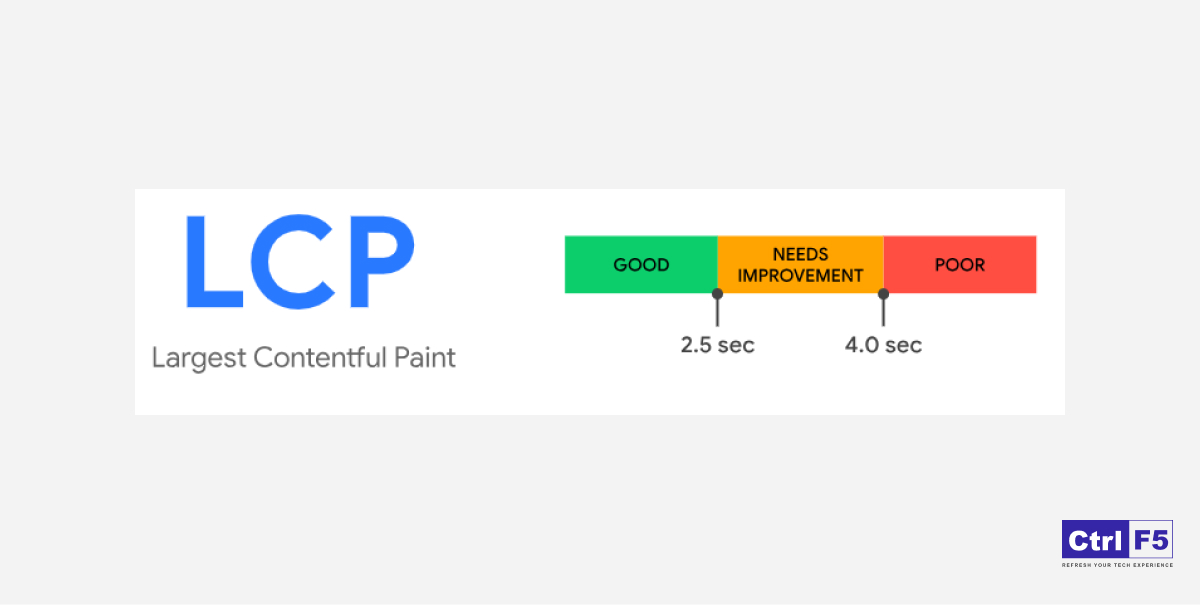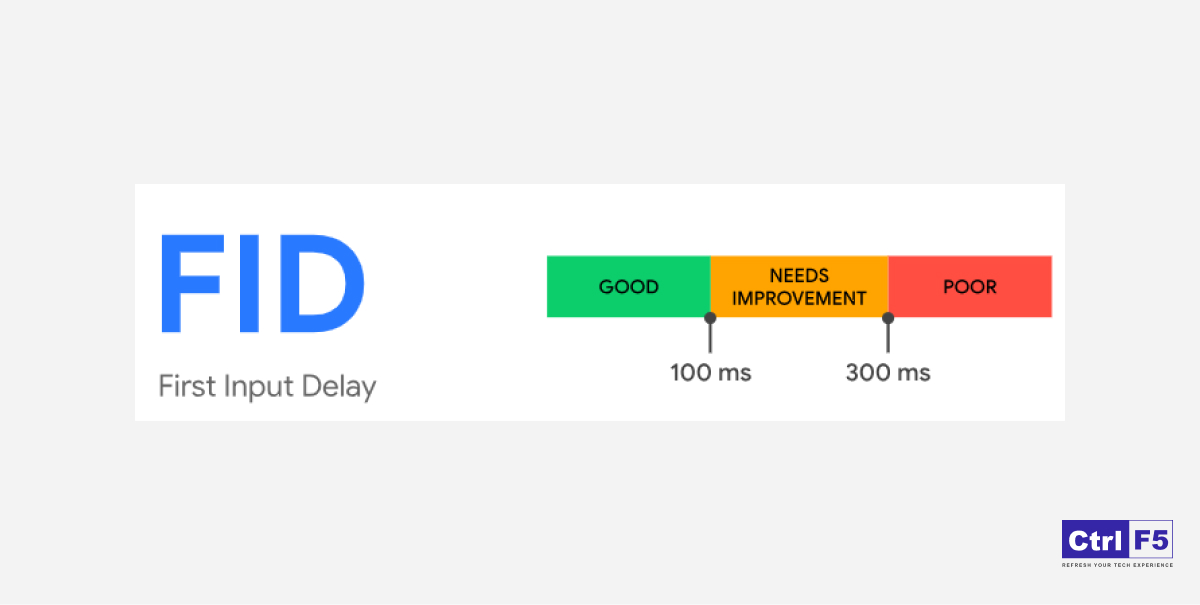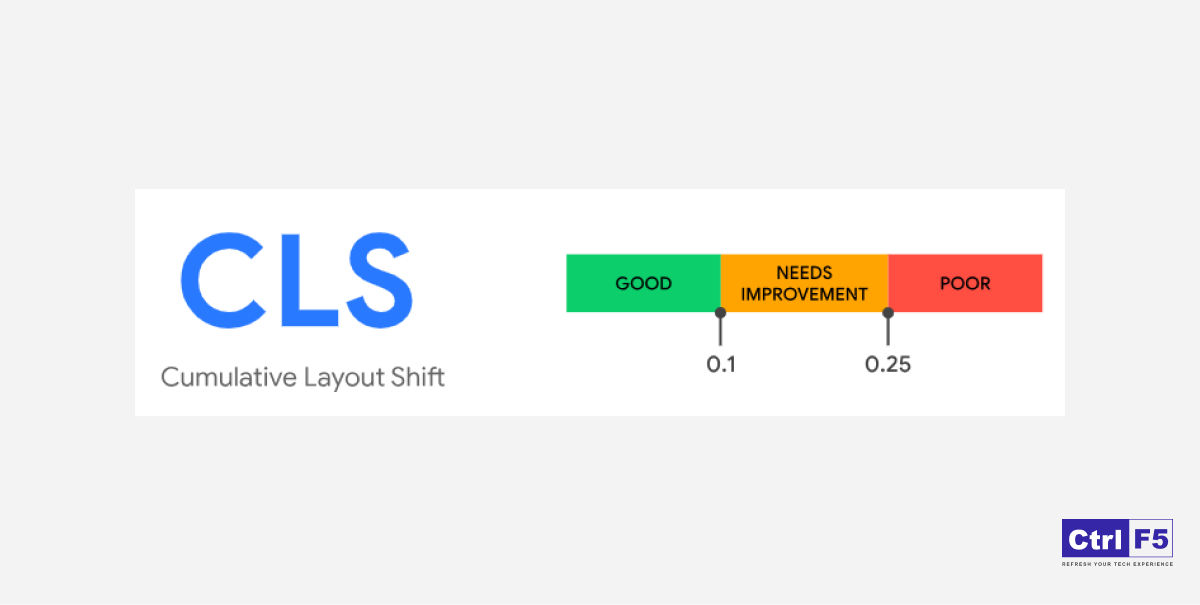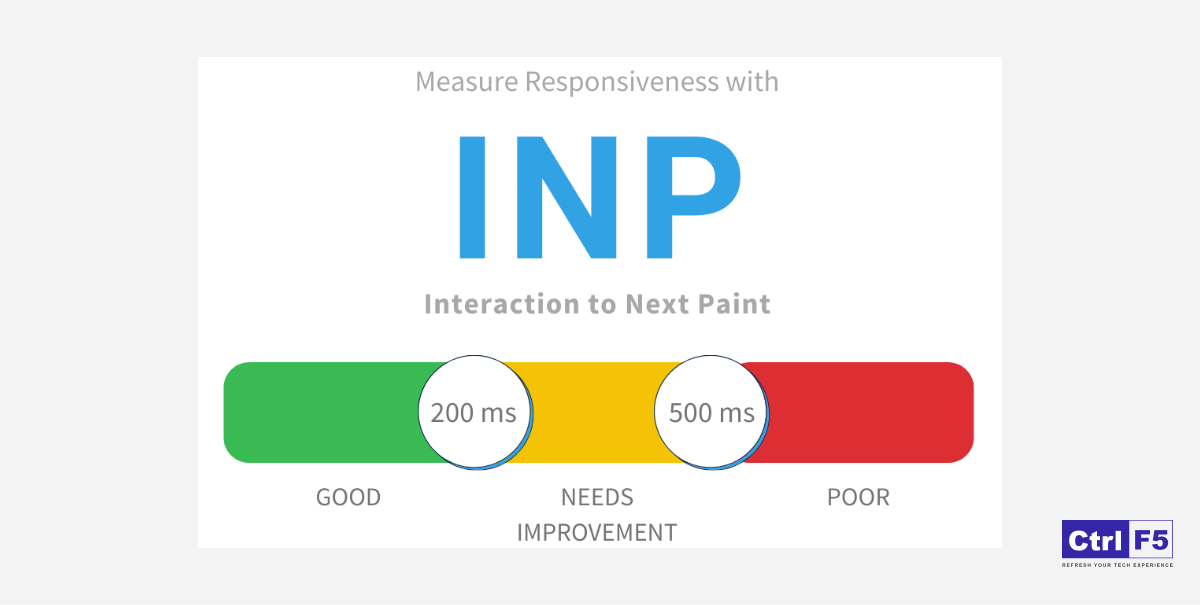Table of Contents
ToggleThe long-term success of any website is dependent on optimizing for a good user experience. Core web vitals can help measure the website experience and identify areas for improvement.
Core Web Vitals is one of the most recent and crucial Page Experience scores. Google measures and evaluates webpages using a few ranking signals. If you don’t optimize your site for these metrics, you could endanger your Search Engine Optimisation (SEO) and overall User Experience (UX).
The good news is that you can actively enhance it once you understand how to improve core web vitals scores and understand how to measure them. This can help ensure you’re giving your users a good experience while also meeting Google’s core web vitals and its guidelines for increased search engine visibility. As well as it has a favorable impact in the short and long run. This blog provided by ControlF5 will refresh your memory on Core Web Vitals.
What are Core Web Vitals?
Core Web Vitals are page experience markers that measure a website’s user experience. Simply said, these indications indicate how quickly consumers can interact with your website and what kind of results they will receive. These signs also indicate how simple it is for users to traverse the website.
The better your page experience scores will be if you increase user experience and make your website better in general. In this writing, we’ll introduce you to Google’s Core Web Vitals, explaining its significance and strategies to improve it.
The Three Core Web Vitals Metrics:
This metric evaluates how quickly a webpage loads. The render time of the largest image or text block visible within the viewport is used to calculate scores.

This metric quantifies a web page’s interactivity: the time between when a user first interacts with a page (by clicking a link, touching a button, or accessing Javascript-powered content) and when the browser begins processing event handlers in response to that interaction.

This assesses layout changes to measure the visual stability of a webpage. Layout shifts happen when a visible element moves from one rendered frame to the next, like when you switch between desktop and mobile browsers.

CLS is calculated as the sum of all individual layout shift scores for each unexpected layout change that occurs throughout the page’s existence. A “zero” score indicates no layout adjustments; a higher score indicates more layout alterations on a page.
Google introduced a new page experience statistic called Interaction to Next Paint (INP). INP is a field experiment metric that measures responsiveness. The responsiveness of a page refers to how rapidly it responds to user inputs and is thus an important metric for tracking user experience.

Significance Of Core Web Vitals
Google Core Web Vitals can help you get better search results. They are significant because they help Google determine how well a website is working and where it might improve.
More specifically, these metrics consider:
- Loading
- Interactivity
- Visual stability
As Google Core Web Vitals is a set of key performance indicators that Google uses to compute the vitality and health of websites. These are only a handful of the elements that Google evaluates when determining the health of a website. It also takes into account smartphone compatibility. This is significant since more individuals are accessing the internet via mobile devices. You could be losing a lot of traffic and income if your website isn’t mobile-friendly.
Another important consideration is website security, which assists you in protecting your site from online risks such as malware and hackers. It protects both your site’s content and your users’ data.
You may help enhance your website’s performance and rank higher in search results by ensuring that it satisfies certain requirements. To put it another way, prioritizing and optimizing Core Web Vitals will enhance the search engine visibility and user experience, and lead you to a Win-win situation!
Top 8 tactics for Improving core web vitals score
Now that we know what Core Web Vitals are and how they work, we can move on to some best practices. Remember that every individual measure you take to enhance the test must be determined by the results of your test. As a result, it’s critical to take into account the suggestions and recommendations supplied by PageSpeed Insights (or other testing tools you utilize).
Here are a few simple techniques on how to improve core web vitals scores.
1. Implement a Caching Solution
Caching your content can help your server run more efficiently. A caching tool saves static HTML versions of your pages, avoiding the need to load them each time a visitor visits your website.
However, as a WordPress user, you have a few options for caching plugins.
Without the assistance of WordPress Experts, you can utilize WordPress plugins to reduce page load times and improve website speed. It provides caching for pages and posts, CSS and JavaScript, database objects, and much more.
Some additional free plugin options include:
- WP Fastest Cache
- LiteSpeed Cache
- WP-Optimize
- WP Rocket
Depending on your web host, you may be able to leverage caching on the server level.
Next.js is a popular open-source React framework that includes tools for developing quick and scalable online apps. It has capabilities like server-side rendering (SSR) which can help to boost performance significantly. Using Next.js, developers may improve the overall user experience by optimizing load times, reducing time to interactive (TTI), and enhancing Core Web Vitals metrics such as First Contentful Paint (FCP) and Largest Contentful Paint (LCP). Furthermore, Next.js combines perfectly with caching solutions such as WP Rocket, allowing for further improvement of web application speed.
2. Eliminate Render-Blocking Resources
The static HTML, CSS, and JavaScript files necessary to render a page on your website are known as render-blocking elements. Scripts in each of these files can prevent your users from viewing the material. They are usually generated by third-party plugins and technologies like Google Analytics.
However, one technique to keep these scripts from negatively impacting your UI/UX desgin (and so helping to enhance Core Web Vitals) is to remove render-blocking resources and minify and delete any unneeded CSS or scripts.
There are several approaches you might use to accomplish this. One method is to reduce the number of white spaces and superfluous comments in your JavaScript and CSS.
The tool is completely free to use. Simply enter your CSS and click the Minify button. The output can then be copied and pasted to download and replace your code.
Another option is to combine your JavaScript and CSS files to save space. This is another chore that WP Rocket’s file optimization tool can assist with.
3. Defer Loading of JavaScript
If you want to improve your FID scores, you can employ a method known as delaying JavaScript loading. This is yet another method for removing render-blocking items.
Because it pauses the loading of JavaScript, this method speeds up the loading of your web pages. In other words, rather than waiting for all JavaScript files to load, it loads other material on the website when a visitor comes. Your files will be forced to wait until everything else on your web page is ready before loading.
You can also tweak your site settings such that the crucial CSS loads ‘above the fold content’ faster. ‘Above the fold’ refers to web page items that appear first.
You can accomplish this by removing the content from the main CSS file and inserting it directly into your code. This will make it load faster, increasing the user experience. Some caching plugins, such as WP Rocket, include an Optimise CSS Delivery option that can be useful in this situation.
4. Use a Content Delivery Network
A material Delivery Network (CDN) is a global network of servers where you can store your material. This means that your site’s content will be served to your users from the servers nearest to them. This can assist to speed up loading times even further.
Using a CDN can help your users’ Largest Contentful Paint (LCP) times. It can also aid in reducing the Time to First Byte (TTFB).
There are various third-party tools available for your WordPress site. In addition to caching, several hosting providers include CDN solutions with their plans. Before adopting one on your own, we recommend checking with your web host to see which offerings (if any) are included with their plans.
5. Properly Size and Optimize Images
Optimising and compressing your photographs to reduce file size is another technique to improve LCP ratings. Image compression software allows you to dramatically reduce image size without sacrificing quality.
Consider utilizing the following image optimization plugins:
- ShortPixel
- EWWW Image Optimizer
- Imagify
- Smush
You can also optimise your photographs by making sure they’re the right size and dimensions. When you upload photos from the best WordPress developer’s editor, the Content Management System (CMS) assigns dimensions automatically.
However, if you manually add photos via code, you must ensure that you define the dimensions to allow for these items. The file size grows in proportion to the size of the photographs.
As a result, it’s prudent to avoid employing superfluous image dimensions for specific regions of your website. Using the right UX/UI characteristics can assist your browser assign the perfect amount of space for your page items, reducing layout shifts.
You can change the width and height characteristics of images and videos on your website by altering the code. To access these properties, right-click on the image in your site’s front end and select Inspect. The Developer Tools panel will appear. You can check there to see if the correct sizes have been assigned.
6. Implement Lazy Loading
We also suggest that you use lazy loading. This helps to ensure that your images load precisely when people arrive at that portion of the web page, rather of loading concurrently with everything else on the page.
Images that load slowly can assist in improving your LCP and loading performance. As there are many reasons you need to start using WordPress Plugins and WordPress image optimization plugins, such as Smush, include slow-loading capabilities.
7. Optimize Your Website Fonts
The fonts you use on your website, like photos, might affect its loading rates. This is due to the fact that they require the browser to download and load the font family, including all weight variations.
Optimising your web fonts can assist in enhancing the performance of your website. This is because optimized web fonts have smaller file sizes and are supplied faster.
A browser may also fail to render text components if the web font associated with them has not yet been loaded. Using fallback fonts, on the other hand, may result in layout adjustments, lowering your CLS score.
We recommend being picky about the fonts you employ on your website. If you’re using more than two fonts, remove them from individual elements and use global fonts to just apply the necessary types and weights. This ensures that just the fonts necessary for the text are downloaded.
8. Upgrade Your Website Hosting
If your site takes an unusually long time to load, it may be time to improve your web hosting. Switching from shared hosting to a dedicated server, for example, can be a fantastic method to improve your LCP.
Your website hosting provider is critical to the performance of your site. It has an impact on everything from page speed to security. As a result, we don’t recommend enough attention on it, especially if you have a large or complicated website. Upgrading your hosting provider or plan, on the other hand, is one of the simplest yet most potent strategies to optimise your website and improve loading speeds. We suggest choosing a managed host that has servers optimized specifically for WordPress and can handle many technical aspects of site performance.
Ending Statement:
Maintaining a successful website requires you to constantly improve your customer experience. You may aid in improving your site’s page experience signals by following the above-mentioned ways and implementing page experience optimization into your SEO strategy.
Improving page experience will not only assist to future-proof your website’s performance by placing it in the greatest position to capitalise on the next algorithm update, but it will also provide positive experiences for users on your website right now. In the above writing, we have mentioned all the strategies on How to Improve Core Web Vitals Scores. Contact us right away if you need any further information about this.
Anurag Pandey
Recent Posts
Categories
Hire Developers
About us
Popular Posts
Tags
Related Articles
The Cost of Building an E-Commerce Store: A Comprehensive Breakdown
Are you a business owner stepping into the e-commerce world and thinking how much does an online store cost?
You might feel confused while trying to find a clear answer, as e-commerce website development costs are changing widely.
How to Build an E-commerce Mobile App Like Temu
In today’s fast-paced technology-driven world, mobile e-commerce apps have changed the shopping experience for users, making it more convenient and accessible than ever before.
Platforms like Temu have set a high standard in the mobile app development industry, combining a user-friendly design, advanced features, and smooth performance.
Future of E-Commerce Mobile App with Flutter: Trends and Possibilities
In today’s tech-driven world, digital shopping is growing rapidly. E-commerce business owners are increasingly looking for ways to make their online stores more personalized and
Sign up for our Newsletter








